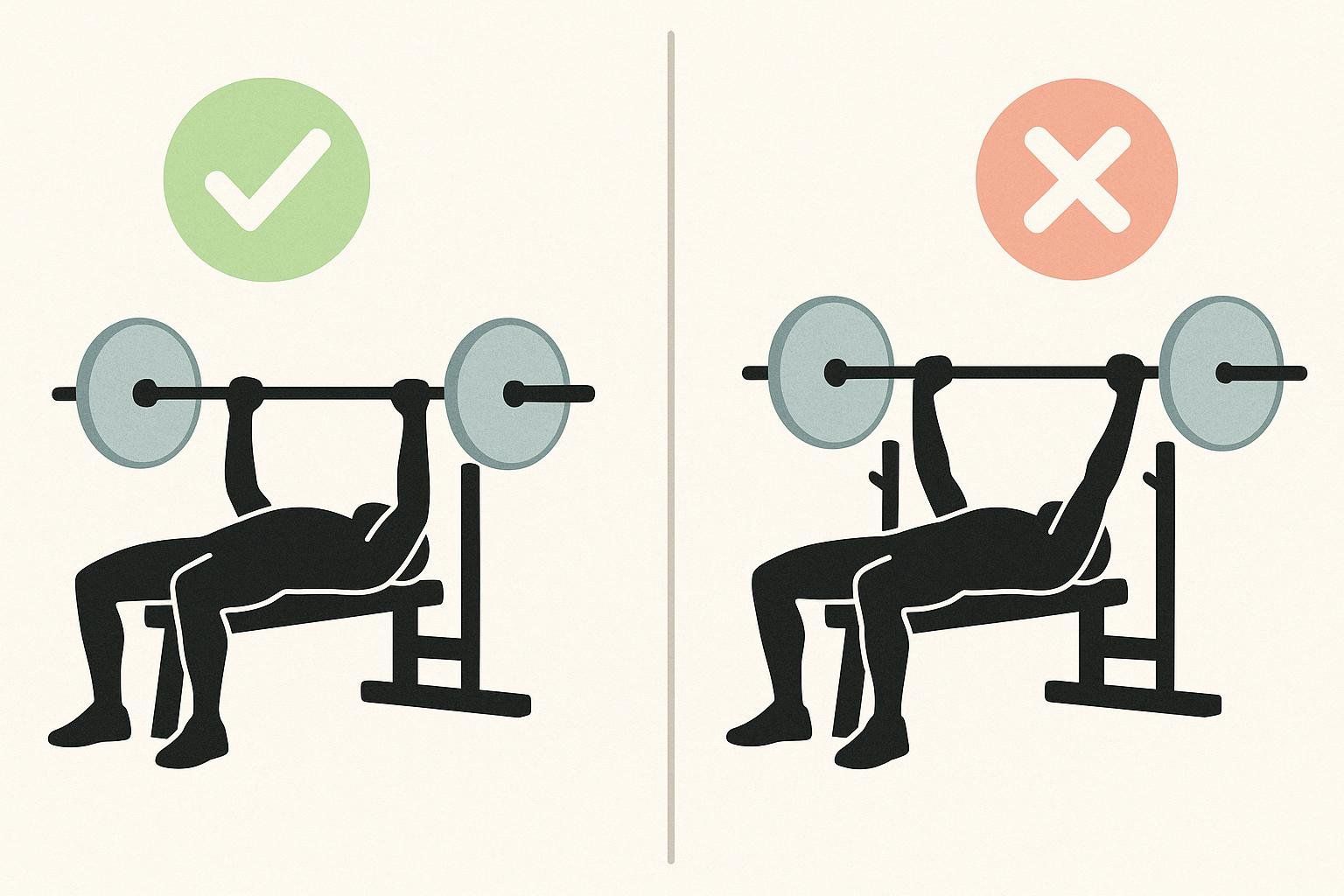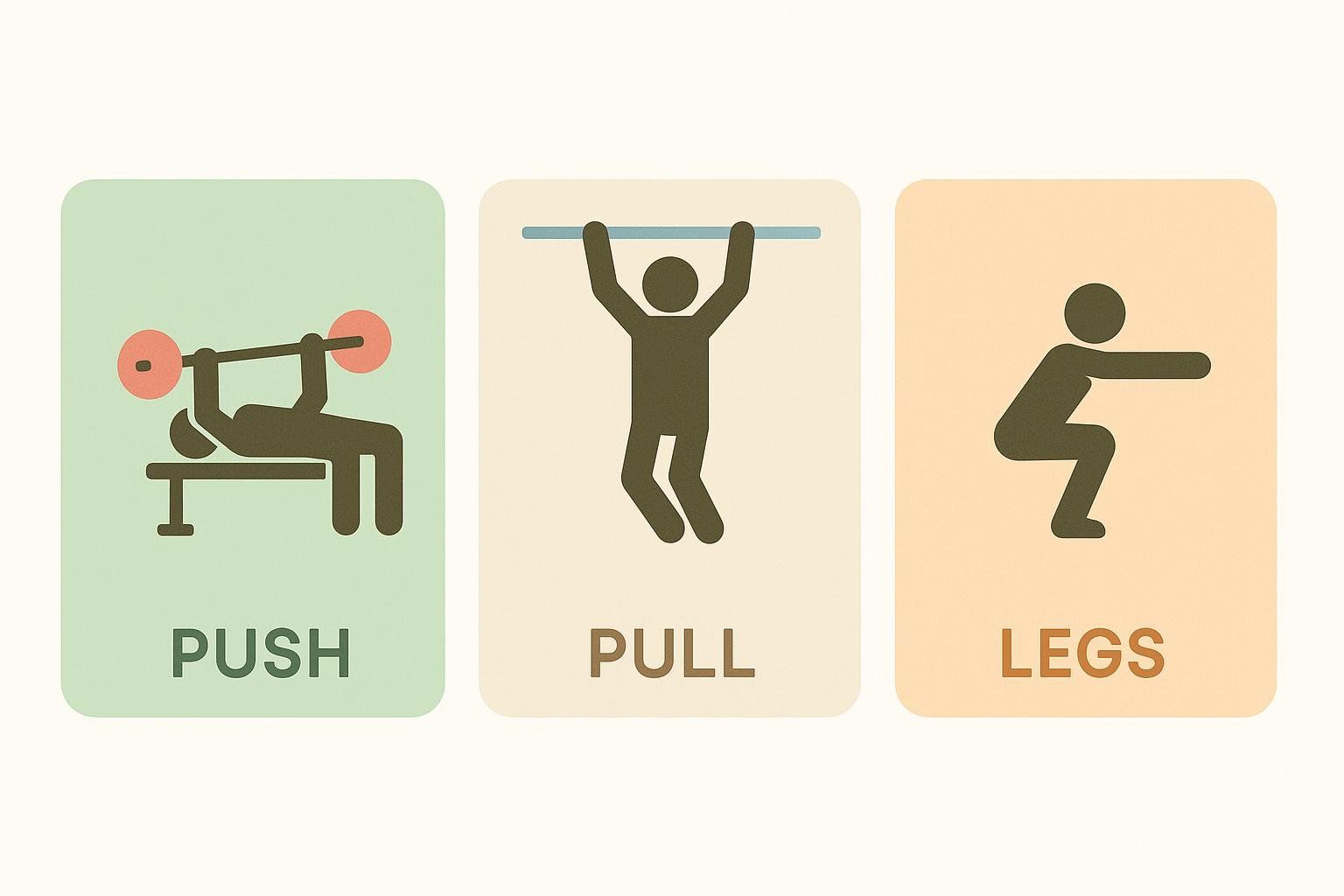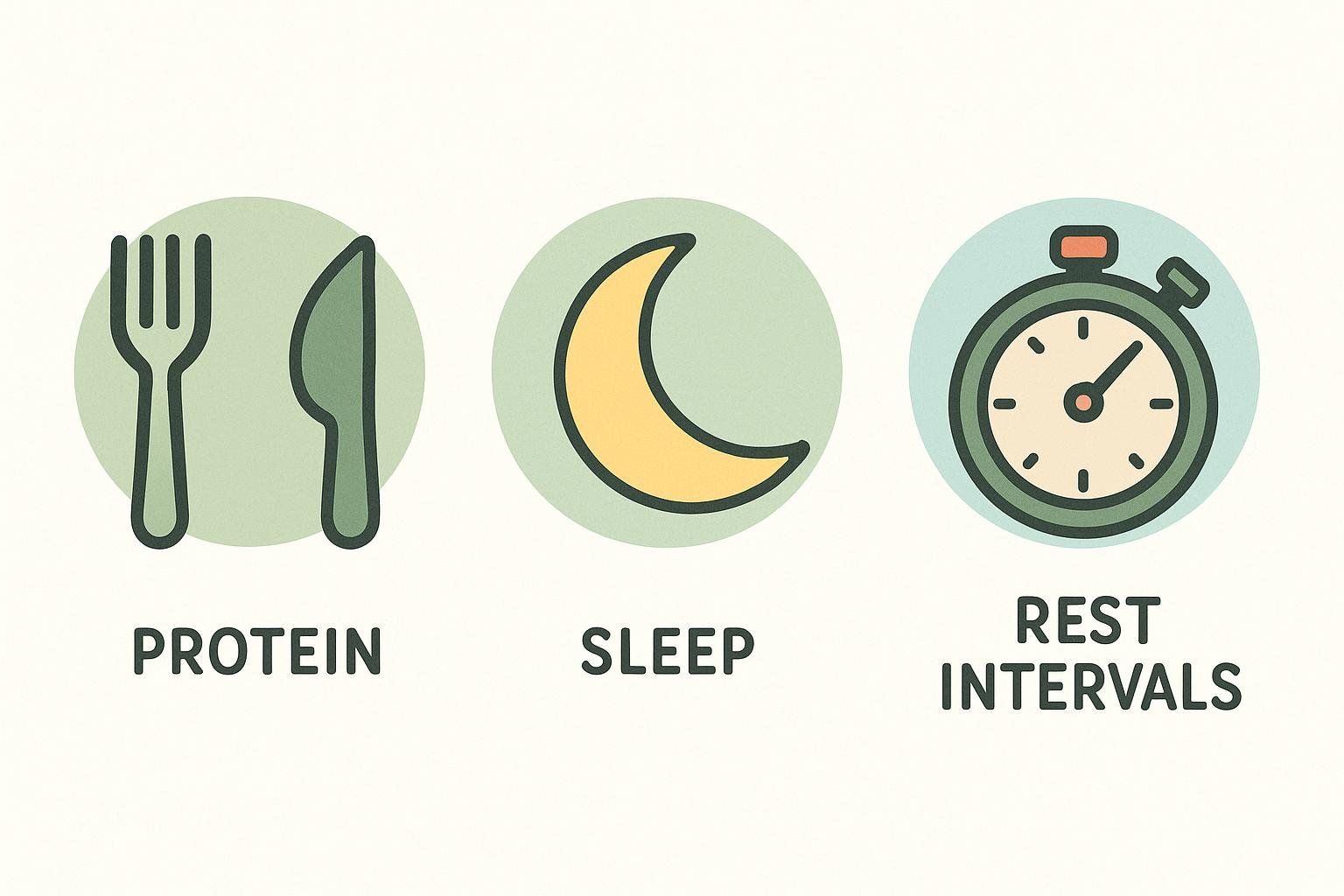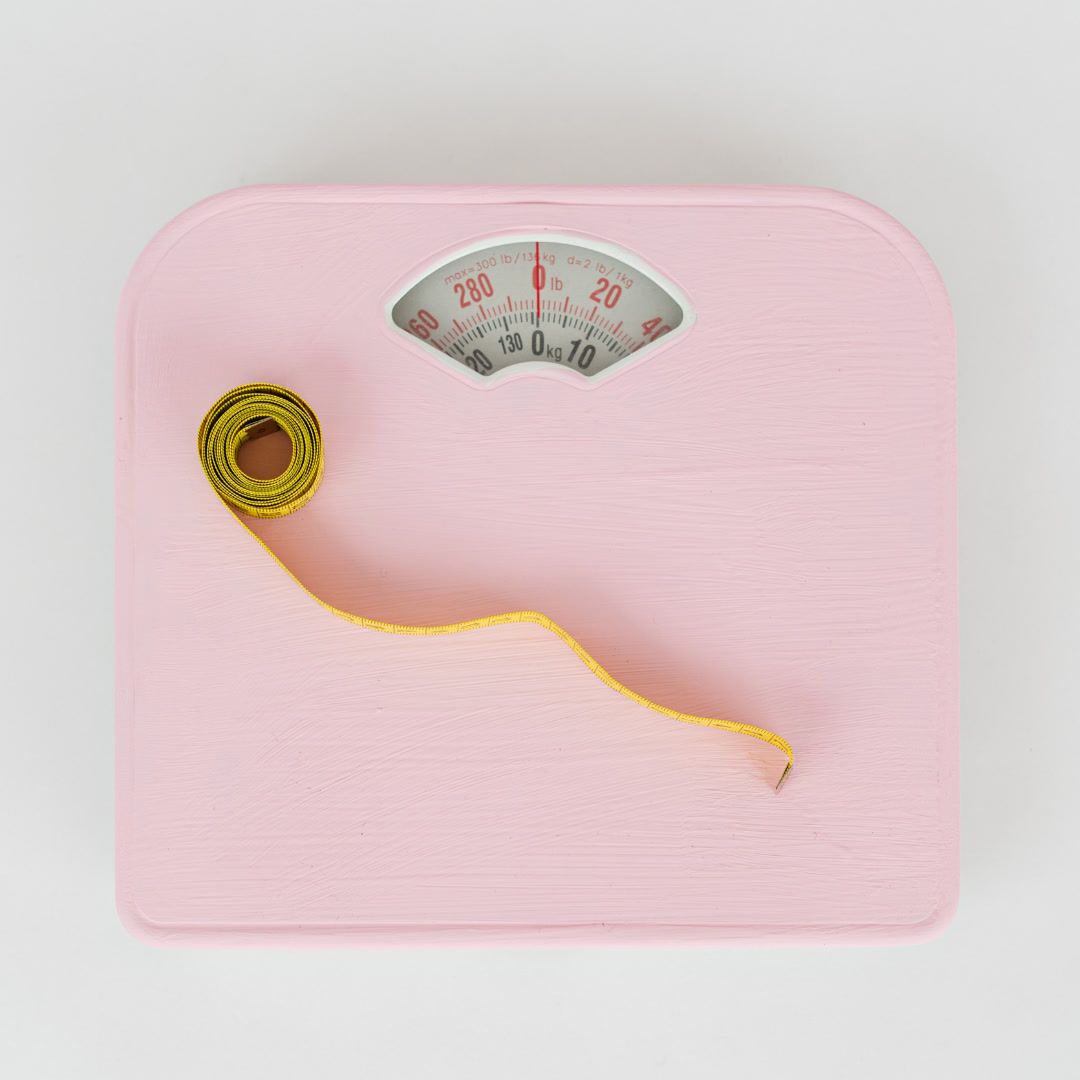Push Day Workout Guide and Science-Backed Routines

Push Day Workout: Science-Backed Routines & Guide
Crush your push day with smart programming that builds your chest, shoulders, and triceps—without burning you out. Use these plug‑and‑play workouts (barbell gym or dumbbell‑only home) and the progression plan below to keep gains compounding.
What is a “push day” (and why it works)?
Push days group movements that push weight away from you: presses, push‑ups, dips, and extensions. They primarily train your chest (pectorals), shoulders (anterior and lateral delts), and triceps. Pairing push with a separate pull day creates natural recovery windows of ~48–72 hours for each muscle group (push–pull overview).
- Related: How a push–pull split fits into a full program: Push–Pull Split Guide & Templates
The science that shapes these workouts
- Volume drives growth: More weekly hard sets per muscle generally produce more hypertrophy up to your recovery limit (Schoenfeld et al., 2017 – dose–response meta‑analysis).
- Frequency isn’t magic: With total volume equated, training a muscle once vs. twice per week yields similar hypertrophy—choose the schedule you can recover from (Schoenfeld et al., 2019 – training frequency meta‑analysis).
- Rest long enough to keep performance high: In trained lifters, 3‑minute rests between hard compound sets built more size/strength than 1‑minute rests (Schoenfeld et al., 2016 – randomized trial).
- Progress gradually: When you can exceed the target reps with solid form, increase load ~2–10% depending on the lift (ACSM Position Stand, 2009).
Want the deeper physiology? See The Ultimate Guide to Hypertrophy.
Quick-start warm‑up (5 minutes)

Spend 3–5 minutes to boost temperature, mobilize shoulders, and rehearse your first press. Example:
- 1 minute: arm circles + band pull‑aparts
- 1 minute: scapular push‑ups
- 1 minute: light incline push‑ups
- 2 minutes: two ramp‑up sets of your first press (8–10 reps, then 5–6 reps)
Need a fuller sequence? Try our Dynamic Warm‑Up (11 Exercises).
Choose your push day
Pick the track that matches your equipment and experience. Unless noted, rest ~2–3 minutes after heavy compounds, 60–90 seconds after isolations (Schoenfeld et al., 2016). Stop most sets with 0–2 reps in reserve (RPE 8–9). New to RPE? Read our RPE Guide.
A) Beginner Gym (45–55 minutes)

| Exercise | Sets × Reps | Notes |
|---|---|---|
| Barbell Bench Press | 3 × 6–8 | Learn tight setup; touch low chest; controlled lower |
| Seated DB Shoulder Press | 3 × 8–10 | Neutral or pronated grip |
| Cable Fly (mid‑to‑low) | 2 × 12–15 | Slight forward lean; pause in squeeze |
| Cable Rope Press‑Down | 3 × 10–12 | Elbows pinned; spread rope at bottom |
| Lateral Raise (DB or cable) | 2 × 12–15 | Lead with elbows; avoid shrugging as you lift |
B) Home Dumbbells Only (30–40 minutes)
| Exercise | Sets × Reps | Notes |
|---|---|---|
| Dumbbell Bench or Floor Press | 4 × 8–12 | If no bench, floor press; pause on floor |
| DB Overhead Press | 3 × 8–12 | Seated on edge of chair/bench if preferred |
| Feet‑Elevated Push‑Up | 3 × 8–15 | 1–2 reps in reserve; slow 2–3 s lower |
| DB High‑to‑Low Press or Fly | 2–3 × 12–15 | From standing, press/fly down‑and‑in arc |
| DB Overhead Triceps Extension | 2 × 10–12 | Keep ribs down; full elbow lockout |
- Note: No bench? Substitute decline/elevated push‑ups and single‑arm floor presses. For other dumbbell‑based shoulder exercises to add variety in future phases, explore our shoulder workouts guide.
C) Intermediate Strength + Size (55–65 minutes)
| Exercise | Sets × Reps | Focus |
|---|---|---|
| Barbell Bench Press | 4 × 5–6 | Heavy compound for tension |
| Overhead Press | 3 × 6–8 | Vertical press emphasis |
| Incline DB Press (15–30°) | 3 × 8–10 | Upper‑chest bias |
| Lateral Raise (cable or DB) | 3 × 12–15 | Controlled; slight lean |
| Dips (BW or weighted) | 3 × 6–10 | Forward lean; shoulder‑friendly depth |
| Cable Rope Overhead Extension | 2 × 12–15 | Long‑head triceps bias |
- Pro tip: Chasing a lower‑chest look? Add 2–3 sets of decline press or high‑to‑low cables; see our Lower Chest Workout.
8‑week progression plan (any track)
Use “double progression”: hit the top of the rep range across all sets two sessions in a row, then add weight ~2–5 lb on DB moves, 5 lb on barbell lifts (or the smallest weight increment available).
- Weeks 1–2: Learn technique; keep 1–2 reps in reserve on every set
- Weeks 3–4: Add 1 set to one chest and one triceps movement (not both in same week)
- Week 5: Small load bumps on main presses; hold isolation volume steady
- Week 6: Push most compound sets to RPE 9 (0–1 RIR)
- Week 7: Keep loads; aim for small rep PRs
- Week 8: Deload volume 30–40% and keep 2–3 RIR to recharge
Total weekly sets target (per muscle): start ~10–12; expand toward 14–20 only if recovery, performance, and results support it.
Technique cues that protect shoulders and elbows

- Bench & DB Presses: Set shoulder blades “down and back,” touch low chest, and keep forearms vertical at the bottom. Avoid extreme flare (>70°).
- Overhead Press: Brace ribs down; press slightly back so the bar finishes over mid‑foot, not out front.
- Dips: Use a slight forward lean; stop shy of painful shoulder extension.
- Lateral Raises: Soft elbows, lead with elbows, and keep ranges pain‑free.
- Triceps Extensions: Full lockout without snapping; if elbows get cranky, sub cables/bands for skull crushers.
For more detailed form cues, review our guides to shoulder workouts and triceps workouts.
How push day fits your week (example schedules)

- 3‑Day PPL: Mon Push • Wed Pull • Fri Legs (see our Push–Pull Split Guide & Templates)
- 4‑Day Push–Pull: Mon Push A • Tue Pull A • Thu Push B • Fri Pull B
- 6‑Day PPL×2: Push • Pull • Legs • Push • Pull • Legs (advanced)
Note: The ACSM guideline (2–3 days/wk for novices, 3–4 for intermediates, 4–5 for advanced) refers to total weekly training sessions in a balanced program—not the number of push days (American College of Sports Medicine Position Stand, 2009).
Nutrition, recovery, and rest intervals

- Protein: Many lifters maximize gains around ≥1.6 g/kg/day; distribute across 3–5 meals for best effect (see evidence in Hypertrophy Guide).
- Sleep: Aim for 7–9 hours; poor sleep undermines strength and hypertrophy adaptations.
- Between‑set rest: For heavy compound lifts, about 3 minutes usually beats 1‑minute rests for size and strength (see Schoenfeld et al., 2016). Save the short rests for lighter accessory work or when you’re on the clock.
FAQs
-
What muscles are trained on push day?
Chest, anterior/lateral delts, and triceps—primarily via presses, push‑ups, dips, raises, and extensions (Healthline overview). -
How many exercises should I do?
4–6 movements per session is plenty: 2–3 compounds, 2–3 accessories. Focus on progression, not endless variety. -
How often should I run push day?
1–2×/week works well. If your total weekly sets are equal, doing push once vs. twice per week yields similar muscle growth—pick the rhythm you recover from and can stick with. -
Do I need long rests to grow?
For your big lifts, yes—around 3 minutes helps you lift more total weight. For smaller isolation moves, 60–90 seconds is fine unless it tanks your performance.
Track real progress with DEXA
When you’re training to change body composition, the mirror can lie. A BodySpec DEXA scan precisely quantifies lean mass by region (arms, trunk), fat mass, bone density, and even visceral fat—so you can verify your push‑day plan is adding muscle where it counts. Learn precisely how a DEXA scan works in our DEXA Body Scan Guide, then book a baseline scan to start tracking your results with data.


